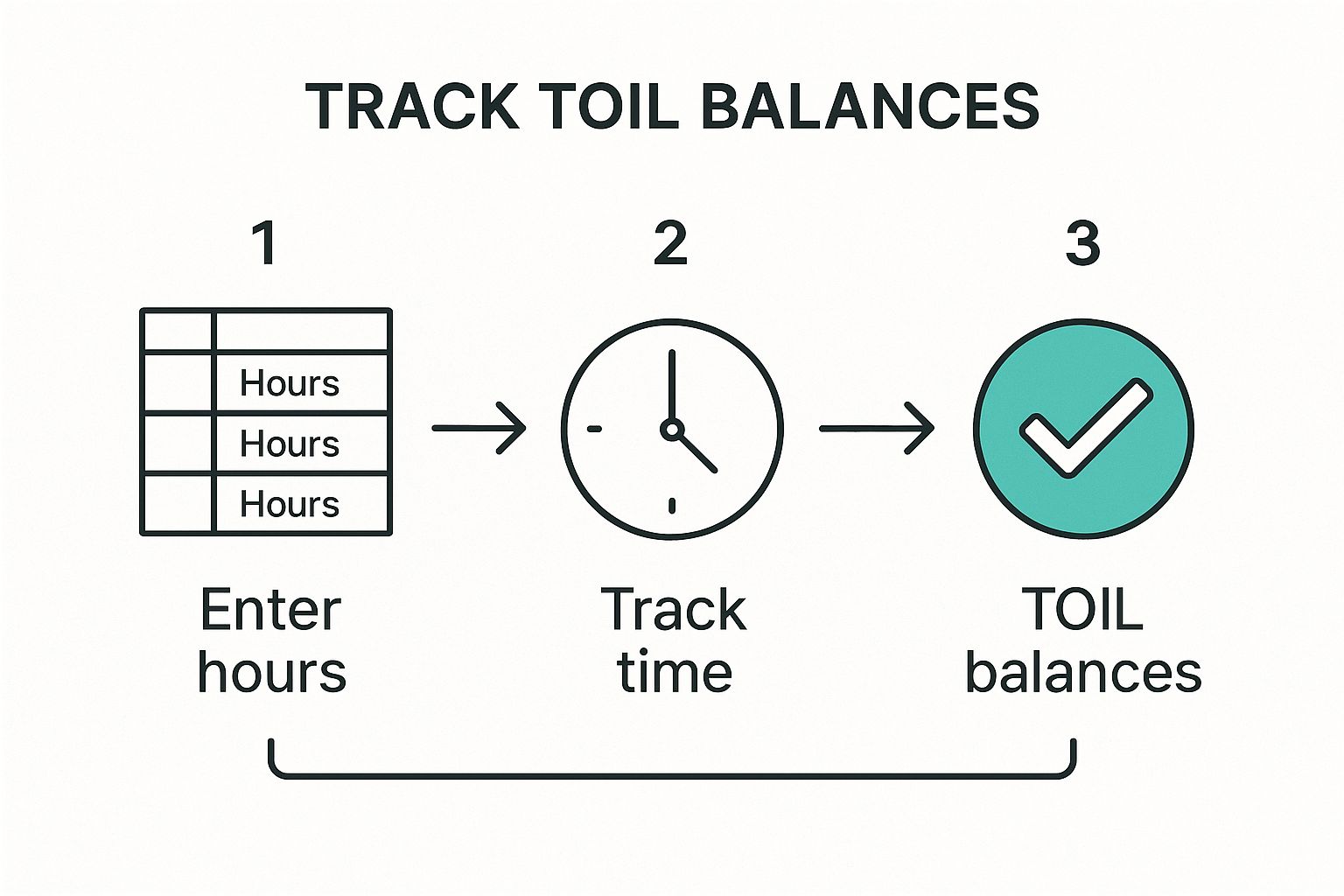A Complete Guide to Days Off in Lieu

Days off in lieu, or TOIL as it’s often called, is a pretty straightforward deal: instead of getting paid extra for working overtime, you get that time back to take as paid leave later. Think of it as banking your extra hours to cash in for a well-deserved day off down the line.
It’s a simple concept that offers more flexibility and a bit more holiday time when you need it most.
Unpacking Time Off in Lieu

The best way to understand days off in lieu is to imagine a "time bank" just for you. Every time you work beyond your contracted hours—maybe to hit a critical deadline or help a colleague out of a jam—you're making a deposit into that bank.
Later on, you can simply "withdraw" those hours and take them as paid time off.
For businesses, this is a really practical way to handle those inevitable busy spells without bumping up the wage bill with overtime payments. It gives them the agility to manage workloads while rewarding people's hard work with something incredibly valuable: personal time.
And for employees, the appeal is obvious. A little extra cash is nice, but getting a whole extra day off to yourself can do wonders for your work-life balance. It’s a tangible way to recharge your batteries after a particularly demanding period at work.
TOIL vs Overtime Pay
It's crucial to remember that TOIL is an alternative to paid overtime, not something you're automatically entitled to under UK law. Whether you get one or the other comes down to what's written in your employment contract and the company's official policy.
This arrangement is just one of several ways employers handle different types of absence and extra work. To get the bigger picture, our guide on the essential types of leave in the UK is a great place to start.
So, how do the two options really stack up? This quick comparison should help clear things up.
TOIL vs Overtime Pay At a Glance
| Aspect | Days Off in Lieu (TOIL) | Overtime Pay |
|---|---|---|
| Compensation Type | Paid time off | Additional wages |
| Primary Benefit | More flexible leave and rest | Increased immediate income |
| Impact on Payroll | Cost-neutral for the business | Increases direct labour costs |
| Employee Appeal | Favours work-life balance | Favours financial reward |
Ultimately, the choice often comes down to personal preference. Some people would rather see the extra money on their payslip, while others will always choose more time to relax and switch off.
The Legal Lowdown on TOIL in the UK

When you start digging into the rules for days off in lieu, UK employment law can feel a little murky. You won't find a dedicated "TOIL Act" to give you all the answers. Instead, the legality of TOIL is pieced together from existing laws, with the most important one being the Working Time Regulations 1998.
This means that while offering time off in lieu is perfectly legal, it has to be done by the book. You can't just rely on a casual chat or a handshake; the arrangement needs to be formalised. It must be clearly laid out in the employment contract or an official company policy that everyone has seen and agreed to.
Getting it in writing is your best bet for avoiding confusion down the line. It makes it crystal clear from the get-go that extra hours are swapped for time off, not extra cash, which is a pretty fundamental part of someone's employment terms.
Working Hours and Rest Breaks
The biggest legal hurdle to watch out for is the 48-hour average working week. According to the Working Time Regulations, you can't require an employee to work more than 48 hours per week on average. This is usually calculated over a 17-week reference period.
A TOIL scheme can't be used as a sneaky way around this rule. Unless an employee has formally signed an opt-out agreement, their total hours worked—including any overtime that's building up their TOIL balance—must not push them over this average.
Any TOIL arrangement that consistently pushes employees beyond the 48-hour weekly average without a formal opt-out is non-compliant. This is a critical point for employers to manage carefully to avoid legal challenges.
On top of that, you have to make sure TOIL doesn't mess with an employee's right to daily and weekly rest breaks. These aren't just a nice-to-have; they're legally required for health and safety. Any system that implicitly encourages staff to skip breaks just to bank more time off is fundamentally flawed and legally risky.
Statutory Leave and Pay
This is a big one: TOIL and statutory annual leave are completely separate things. In the UK, almost every worker has a right to 5.6 weeks of paid holiday a year. You can't mix the two.
A TOIL policy can never be used to replace or eat into this legal holiday entitlement. You can’t, for instance, offer an employee time off in lieu instead of their statutory leave. It's best to think of TOIL as a separate benefit, an optional extra that sits on top of their core rights. This protection also covers bank holidays, which are often included in the statutory minimum.
Interestingly, the evolution of UK public holidays on timetastic.co.uk shows a shift from over 30 religious festivals to the structured system we have now, ensuring most people get at least 28 paid days off a year.
Finally, always keep the National Minimum Wage (NMW) in mind. If an employee works a lot of extra hours for TOIL, their effective hourly rate for that pay period could dip. You need to ensure their total pay, when divided by all hours worked, never drops below the NMW. If it does, you're breaking the law.
Crafting a Fair and Effective TOIL Policy
Wing it with days off in lieu, and you’re asking for trouble. Without a clear, written policy, what starts as a flexible perk can quickly descend into confusion, arguments, and a feeling that the system just isn't fair. A solid policy acts as your company's rulebook, making sure everyone is on the same page. It’s your best defence against operational chaos, and it protects your team from being treated inconsistently.
Putting this document together doesn’t have to be a huge headache. The real goal here is total transparency. You want to answer all the potential questions before anyone even thinks to ask them. By mapping out the entire process from start to finish, you can build a framework that offers genuine flexibility without sacrificing control.
The Must-Have Elements of Your TOIL Policy
Think of your policy as the instruction manual for your company's TOIL system. It needs to be a practical guide that leaves zero room for misinterpretation, clearly spelling out the who, what, when, and how of earning and taking time off.
Here’s what you absolutely need to include:
- Who is eligible? Be specific about which employees can earn TOIL. Is it just for salaried staff? Does it apply to everyone? Do new hires have to pass their probation period first?
- How is it approved? This is a big one. No overtime should be worked without a manager's say-so beforehand. Lay out the exact steps an employee needs to take to get that green light before they put in the extra time. This is critical for keeping an eye on workloads and costs.
- What’s the exchange rate? Define exactly how TOIL is earned. Most companies stick with a simple 1:1 ratio – one hour of overtime gets you one hour of leave. But you might want to offer a better rate, say 1.5 hours of TOIL for every hour worked on a weekend or a bank holiday, to reward that extra commitment.
- How are hours logged? Explain precisely how and when employees must record their overtime. Whether it’s a simple spreadsheet, a formal timesheet, or a software system, the process needs to be crystal clear to make sure every hour is tracked accurately.
Setting Sensible Boundaries and Managing Expectations
Once the basics are covered, your policy needs to tackle the lifecycle of that banked time. This is where you can head off common problems, like employees hoarding huge amounts of leave, which can turn into a logistical nightmare when they finally decide to use it. A good policy sets reasonable limits that work for both the employee and the business.
A strong TOIL policy isn't just a list of rules; it's about building a system people can trust. When your team sees that the process is consistent, transparent, and fair, they’ll see days off in lieu as the genuine benefit it's meant to be.
To keep things running smoothly, make sure your policy also addresses these crucial points:
Expiry Dates and Blackout Periods
You have to set a "use by" date for TOIL. A window of 3 to 12 months is pretty standard and strikes a good balance. It gently nudges people to take the breaks they’ve earned, which is great for preventing burnout and stops leave balances from getting out of hand. You should also be upfront about any blackout periods—like your busiest sales quarter or the Christmas rush—when taking TOIL might be restricted.
What Happens When Someone Leaves?
This needs to be spelled out, no exceptions. What happens to an employee's accrued TOIL when they hand in their notice? There are two main ways to handle this, and your policy must state which one you use:
- Pay it out: The company calculates the value of the unused hours and adds it to their final paycheque.
- Use it up: The employee is required to take their accrued TOIL as part of their notice period.
Getting this down in writing ensures every departure is handled fairly and consistently, preventing any last-minute debates or bad feelings.
Calculating and Tracking Days Off in Lieu
Once you've got a fair TOIL policy sorted, the next challenge is the day-to-day management of it all. Getting the calculations right and tracking everything transparently is crucial. If you don't, you risk creating administrative headaches and, worse, a system that nobody trusts. The aim should be a process that’s straightforward for managers and crystal clear for employees.
Most companies keep things simple with a straight hour-for-hour swap. If someone stays late for four hours to get a project over the line, they earn four hours of TOIL. Simple. However, your policy could offer a bit more to reward people for working particularly unsociable hours, like a weekend or a bank holiday.
Common TOIL Calculation Rates
Offering a premium rate is a great way to acknowledge the extra sacrifice an employee makes when giving up their personal time. It’s a tangible way of saying "we appreciate it." Here are a couple of popular models:
- Standard Rate (1:1): One hour of overtime equals one hour of TOIL. This is the go-to for regular weekday overtime—it’s clean, simple, and easy for everyone to follow.
- Premium Rate (1.5:1): One hour of weekend overtime equals one and a half hours of TOIL. This provides a much stronger incentive for staff who are asked to give up their Saturday or Sunday.
Let's look at an example. Say an employee works a full eight-hour day on a Saturday at that premium rate. They would earn 12 hours of TOIL (8 hours x 1.5). That’s enough for a full day off plus a half-day to use later. Spelling this out in your policy prevents any misunderstandings down the line.
Effective Tracking Methods
Trying to track all this manually can get messy, fast. A shared spreadsheet might seem like a good idea for a tiny team, but it’s a recipe for human error and offers zero real-time visibility as you grow.
The secret to a successful TOIL system is transparency. When employees can see their accrued balance whenever they want, it builds trust. It also empowers them to manage their own time off, which takes a huge administrative weight off their manager’s shoulders.
This is where modern software really shines, automating the whole process from start to finish.
This infographic shows just how much simpler a digital system makes tracking TOIL balances.
 By handling the calculations and updates automatically, these tools get rid of mistakes and give both staff and managers instant clarity.
By handling the calculations and updates automatically, these tools get rid of mistakes and give both staff and managers instant clarity.
Using dedicated software makes managing days off in lieu a completely seamless experience. As our guide to online leave management systems explains, these platforms build TOIL right into the regular holiday booking flow. An employee can see their exact balance on their dashboard and request to use their accrued time just as they would for any other type of leave.
Common TOIL Pitfalls and How to Dodge Them
Even with the best intentions, a days off in lieu system can get messy if you're not careful. When TOIL is managed loosely, it can quickly turn from a great perk into a source of confusion, unfairness, and even a logistical nightmare. The trick is to spot the common pitfalls early and build your process to avoid them.
One of the biggest headaches is leave hoarding. If you don't set clear ground rules, some employees will stockpile their TOIL like a backup holiday fund. This might not seem like a problem at first, but it creates a massive liability. Imagine several people trying to cash in months' worth of accrued time off at once – you’d be facing a serious staffing crisis.
Another classic issue is inconsistency. When one manager is generous with approvals and another is a stickler for the rules, it breeds resentment. People start to feel the system is unfair, which is a fast track to damaging team morale and trust.
Capping the TOIL Bank
The simplest way to stop TOIL from piling up is to give it an expiry date. This nudges people to actually take the rest they've earned, which is the whole point – preventing burnout and keeping your team healthy.
A "use-it-or-lose-it" policy is the standard for a reason. Giving employees a clear window to use their TOIL, usually somewhere between three and twelve months, keeps it working as a short-term reward for extra effort, not a long-term savings plan.
This is a big deal in the UK, where the culture can sometimes make people hesitant to take time off. UK workers get a decent median of 27 days of annual leave, but many don't take it all. Research from 2023 found that only 39% of UK employees used their full holiday allowance. You can get more insights into these trends over at timetastic.co.uk. Encouraging staff to use their days off in lieu promptly is a great way to promote a healthier work-life balance.
Keeping Things Fair and Consistent
For any TOIL policy to work, it has to be applied the same way for everyone, no exceptions. That means having clear, non-negotiable processes that the whole company understands and follows.
Here are three practical ways to iron out those consistency issues:
- Insist on Pre-Approval: Make it a hard-and-fast rule: no overtime gets worked without written approval from a manager beforehand. This simple step stops arguments about what hours count for TOIL and gives managers a handle on workloads before they spiral.
- Use a Single Tracking System: Ditch the spreadsheets and sticky notes. Whether you use dedicated software like Annual Leave Tracker or a standardised company timesheet, having one central place to log and track TOIL is vital. It becomes the single source of truth and kills off any "he said, she said" disputes.
- Train Your Managers: Your line managers are the gatekeepers of this system, so make sure they know the policy inside and out. When they all apply the rules in the same way, you build a culture where everyone trusts the process is fair.
Is a TOIL System Right for Your Business?
Deciding whether to bring in a days off in lieu system isn't just a process change; it's a decision that shapes your company culture. Get it right, and a TOIL scheme can be a fantastic, cost-effective way to manage busy spells, rewarding your team's extra effort with the one thing they can't buy: time.
But if it's handled badly, it can quickly spiral into an administrative nightmare and breed resentment.
From a business perspective, the biggest draw is financial. Instead of paying out for overtime at premium rates, you’re compensating staff with paid leave. This is a game-changer for managing payroll, especially when workloads ebb and flow. It also sends a strong message, helping you attract and keep great people who value their work-life balance more than a few extra pounds in their payslip.
The flip side, of course, is the admin. Without a rock-solid way to track everything, you're opening the door to disputes over who’s owed what. You also risk scheduling chaos if half the team wants to use their accrued TOIL at the same time. It takes real diligence and a crystal-clear process to keep it all straight.
A Balanced View for Your Team
For your employees, the benefit is simple and powerful: more holiday. Earning an extra day off after pushing through a tough project is a genuinely valued perk. It's a direct investment in their well-being, helping to head off burnout by giving them the freedom to rest and recharge when they really need it.
The danger, however, is accidentally creating a culture where unpaid overtime becomes the default expectation. If the system isn't managed carefully, people can feel pressured to work longer hours just to stay on top of their normal workload, blurring the line between contracted hours and genuine overtime.
Ultimately, you have to weigh the benefits of flexibility and cost control against the administrative load and the potential cultural pitfalls. For many companies, a well-thought-out TOIL policy, backed up by the right tools, hits that sweet spot. Exploring different HR systems for small businesses can make all the difference, automating the tracking and approvals to keep things simple and fair for everyone.
Frequently Asked Questions About Time Off in Lieu
Even with the best-written policy, some specific questions about days off in lieu are bound to pop up. Let's tackle some of the most common ones that employers and employees run into.
Can My Employer Force Me to Take TOIL Instead of Overtime Pay?
This all comes down to what’s in your employment contract. If your contract explicitly says that extra hours are compensated with TOIL, then that’s the deal you’ve both agreed to. It’s completely above board.
However, if your contract promises paid overtime—or doesn’t mention TOIL at all—your employer can't just decide to give you time off instead of pay. Changing that would require a formal variation to your contract, which you'd have to agree to.
What Happens to My TOIL When I Leave My Job?
Your company’s TOIL policy should be your first port of call. It will usually outline one of two scenarios:
- You'll get paid for it. Your employer will calculate the value of the hours you've banked and add it to your final payslip.
- You'll have to take the time off. You might be asked to use up your accrued days off in lieu as part of your notice period, effectively finishing work a bit earlier.
If the policy is vague or non-existent, it's crucial to have a conversation with your manager or HR. You’ll need to agree on a fair way to handle your accrued hours before you leave.
Is There a Time Limit for Using My TOIL?
Yes, almost always. Most companies put an expiry date on TOIL to stop it from building up indefinitely, which can become a real headache for scheduling and finances. A typical time limit is anywhere from three to twelve months. This should be crystal clear in your policy so everyone knows where they stand.
Managing days off in lieu without getting buried in spreadsheets doesn't have to be a chore. A proper tool can make all the difference. See how Annual Leave Tracker automates everything from tracking hours to approving requests, keeping the whole process transparent and fair for everyone involved.
You can check out all the features at https://www.annualleavetracker.com.
Ready to Transform Your Leave Management?
Join 500+ companies using Annual Leave Tracker to streamline their HR processes.


